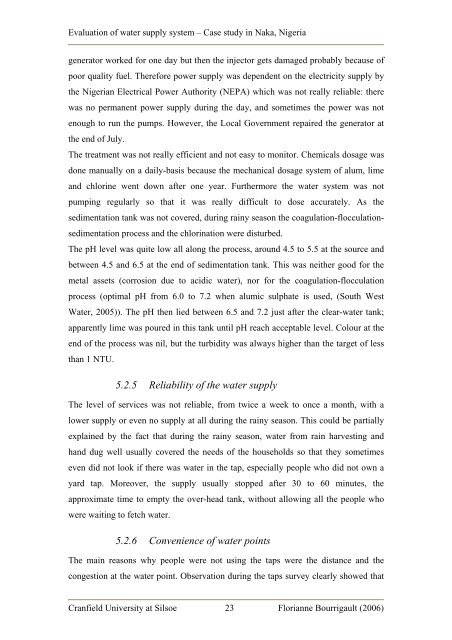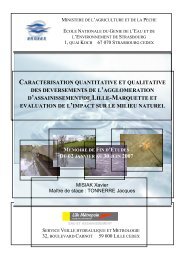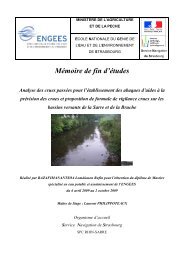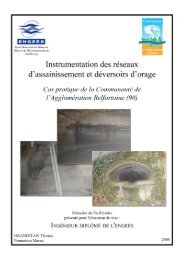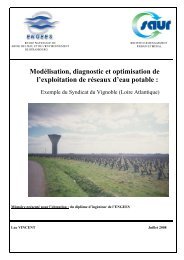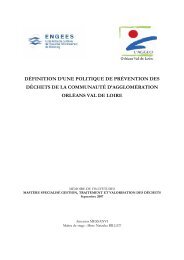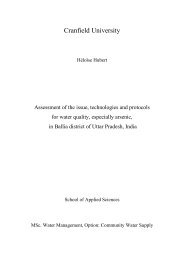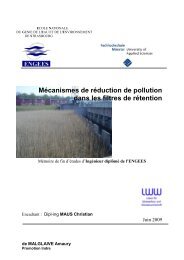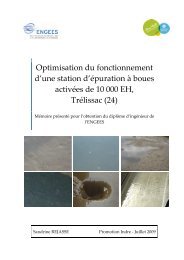Evaluation of water supply system Case study in Naka ... - ENGEES
Evaluation of water supply system Case study in Naka ... - ENGEES
Evaluation of water supply system Case study in Naka ... - ENGEES
- No tags were found...
Create successful ePaper yourself
Turn your PDF publications into a flip-book with our unique Google optimized e-Paper software.
<strong>Evaluation</strong> <strong>of</strong> <strong>water</strong> <strong>supply</strong> <strong>system</strong> – <strong>Case</strong> <strong>study</strong> <strong>in</strong> <strong>Naka</strong>, Nigeriagenerator worked for one day but then the <strong>in</strong>jector gets damaged probably because <strong>of</strong>poor quality fuel. Therefore power <strong>supply</strong> was dependent on the electricity <strong>supply</strong> bythe Nigerian Electrical Power Authority (NEPA) which was not really reliable: therewas no permanent power <strong>supply</strong> dur<strong>in</strong>g the day, and sometimes the power was notenough to run the pumps. However, the Local Government repaired the generator atthe end <strong>of</strong> July.The treatment was not really efficient and not easy to monitor. Chemicals dosage wasdone manually on a daily-basis because the mechanical dosage <strong>system</strong> <strong>of</strong> alum, limeand chlor<strong>in</strong>e went down after one year. Furthermore the <strong>water</strong> <strong>system</strong> was notpump<strong>in</strong>g regularly so that it was really difficult to dose accurately. As thesedimentation tank was not covered, dur<strong>in</strong>g ra<strong>in</strong>y season the coagulation-flocculationsedimentationprocess and the chlor<strong>in</strong>ation were disturbed.The pH level was quite low all along the process, around 4.5 to 5.5 at the source andbetween 4.5 and 6.5 at the end <strong>of</strong> sedimentation tank. This was neither good for themetal assets (corrosion due to acidic <strong>water</strong>), nor for the coagulation-flocculationprocess (optimal pH from 6.0 to 7.2 when alumic sulphate is used, (South WestWater, 2005)). The pH then lied between 6.5 and 7.2 just after the clear-<strong>water</strong> tank;apparently lime was poured <strong>in</strong> this tank until pH reach acceptable level. Colour at theend <strong>of</strong> the process was nil, but the turbidity was always higher than the target <strong>of</strong> lessthan 1 NTU.5.2.5 Reliability <strong>of</strong> the <strong>water</strong> <strong>supply</strong>The level <strong>of</strong> services was not reliable, from twice a week to once a month, with alower <strong>supply</strong> or even no <strong>supply</strong> at all dur<strong>in</strong>g the ra<strong>in</strong>y season. This could be partiallyexpla<strong>in</strong>ed by the fact that dur<strong>in</strong>g the ra<strong>in</strong>y season, <strong>water</strong> from ra<strong>in</strong> harvest<strong>in</strong>g andhand dug well usually covered the needs <strong>of</strong> the households so that they sometimeseven did not look if there was <strong>water</strong> <strong>in</strong> the tap, especially people who did not own ayard tap. Moreover, the <strong>supply</strong> usually stopped after 30 to 60 m<strong>in</strong>utes, theapproximate time to empty the over-head tank, without allow<strong>in</strong>g all the people whowere wait<strong>in</strong>g to fetch <strong>water</strong>.5.2.6 Convenience <strong>of</strong> <strong>water</strong> po<strong>in</strong>tsThe ma<strong>in</strong> reasons why people were not us<strong>in</strong>g the taps were the distance and thecongestion at the <strong>water</strong> po<strong>in</strong>t. Observation dur<strong>in</strong>g the taps survey clearly showed thatCranfield University at Silsoe 23 Florianne Bourrigault (2006)


